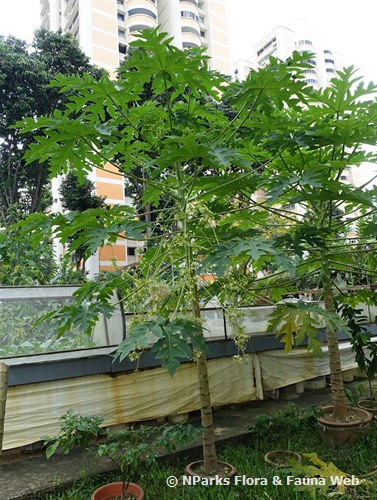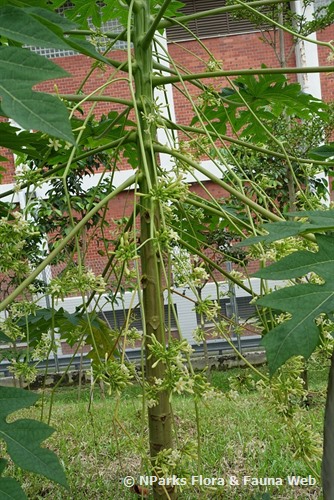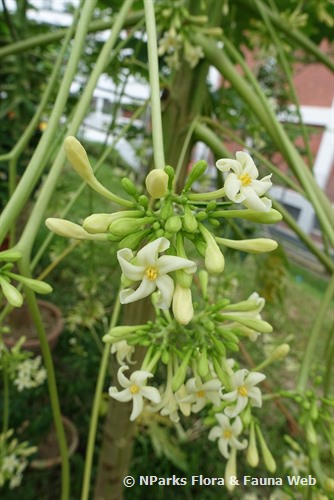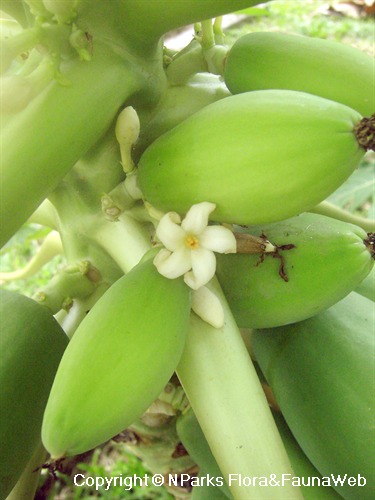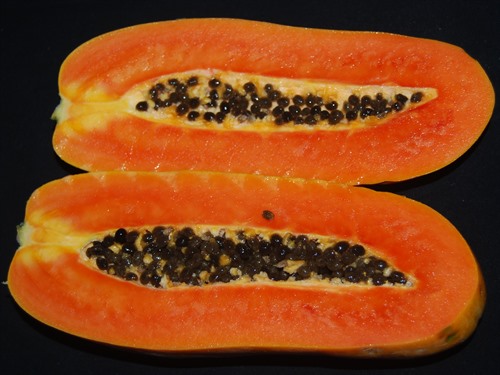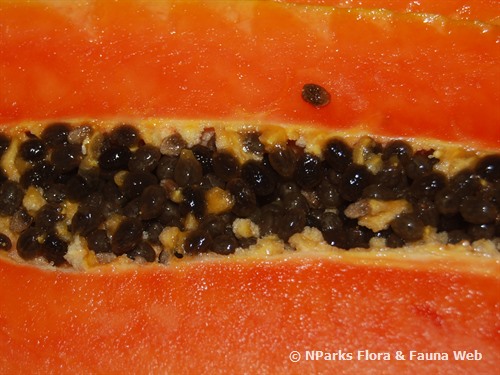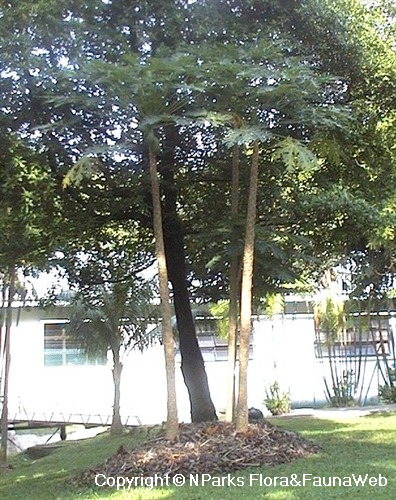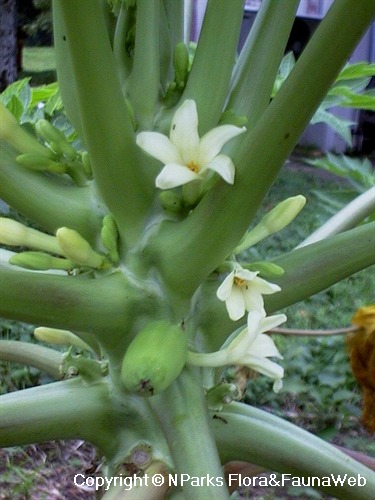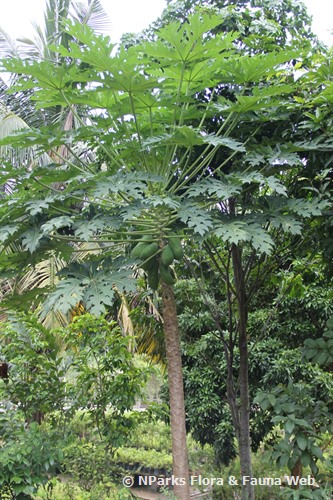
Back
Carica papaya L.
| Family Name: | Caricaceae |
| Synonyms: | Carica posoposa, Carica carica, Carica peltata |
| Common Name: | Papaya, Betik, Pawpaw, Betek, Melon Tree, Ketalah, 木瓜, 番木瓜 |
Name
Classifications and Characteristics
| Plant Division | Angiosperms (Flowering Seed Plants) (Dicotyledon) |
|---|---|
| Plant Growth Form | Herbaceous Plant |
| Mode of Nutrition | Autotrophic |
| Plant Shape | Umbrella |
| Maximum Height | 2 m to 10 m |
Biogeography
| Native Distribution | Central America |
|---|---|
| Native Habitat | Terrestrial |
| Preferred Climate Zone | Tropical, Sub-Tropical / Monsoonal |
| Local Conservation Status | Non-native (Spontaneous (Casual)) |
Description and Ethnobotany
| Growth Form | It is a very large herbaceous plant which grows up to 8 - 10 m tall. |
|---|---|
| Crown | Umbrella-like due to the canopy of palmate-lobed leaves. |
| Foliage | Leaves are lobed, leaf stalks measuring up to 1 m long, alternately arranged on the stem. |
| Stems | Stem single, unbranched, non-woody, has scars of old leaf base. |
| Flowers | Some papaya plants are dioecious (having male and female flowers in separate tree) while others are hermaphroditic (having both male and female flowers in one tree). Trumpet-shaped, fragrant, yellow to white, males in long raceme, females in small clusters or sometimes solitary. |
| Fruit | Large, fleshy, melon-like shape, hanging in clusters which are attached to the stem top just below the leaves, green when young and ripens to orange-yellow.. |
| Cultivation | Grown for fruit production from seeds. It is advised to wrap / bag the fruits to avoid attacks from the fruit flies. |
| Etymology | The genus Carica means from Caria (mistakenly thought to be the origin). |
| Ethnobotanical Uses | Edible Plant Parts : Edible Fruits, Edible Seeds Food (Fruit or Vegetable): The sweet and juicy fruits are eaten or made as ingredients in jellies or preserves, or cooked as vegetables. (Herb or Spice): The black seeds are ground and used as a substitute for black pepper due to their sharp and spicy taste. Medicinal: The latex was said to be effective against toothache. Others: The enzyme extracted from young papaya's milky sap, called as papain, is used as a meat tenderizer, and in chewing gum production. Papaya is also used in shampoos and cosmetics. |
Landscaping Features
| Desirable Plant Features | Fragrant (Flowers) |
|---|---|
| Landscape Uses | Container Planting, General, Parks & Gardens |
Fauna, Pollination and Dispersal
| Fauna Pollination Dispersal Associated Fauna | Bird-Attracting |
|---|---|
| Seed or Spore Dispersal | Biotic (Fauna) |
Plant Care and Propagation
| Light Preference | Full Sun |
|---|---|
| Water Preference | Moderate Water |
| Plant Growth Rate | Fast |
| Rootzone Tolerance | Easy to Grow, Moist Soils, Well-Drained Soils, Fertile Loamy Soils |
| Propagation Method | Seed |
Foliar
| Foliage Retention | Deciduous |
|---|---|
| Mature Foliage Colour(s) | Green |
| Foliar Type | Simple / Unifoliate |
| Foliar Attachment to Stem | Petiolate |
| Foliar Shape(s) | Non-Palm Foliage (Palmate) |
| Foliar Venation | Palmate |
| Leaf Area Index (LAI) for Green Plot Ratio | 4.5 (Shrub & Groundcover - Dicot) |
Floral (Angiosperm)
| Flower & Plant Sexuality | Unisexual & Bisexual Flowers(Sub-dioecious) |
| Flower Colour(s) | White |
|---|---|
| Flower Texture(s) | Smooth |
| Flower Grouping | Solitary, Cluster / Inflorescence |
| Flower Location | Axillary |
| Individual Flower Shape | Trumpet-shaped |
| Inflorescence Type | Raceme |
| Flowering Period | Free-Flowering |
Fruit, Seed and Spore
| Mature Fruit Colour(s) | Orange |
|---|---|
| Mature Fruit Texture(s) | Smooth |
| Fruit Classification | Simple Fruit |
| Fruit Type | |
| Mature Seed Colour(s) | Black |
| Seed Quantity Per Fruit | Numerous (>20) |
Image Repository
Others
| Master ID | 1492 |
|---|---|
| Species ID | 2785 |
| Flora Disclaimer | The information in this website has been compiled from reliable sources, such as reference works on medicinal plants. It is not a substitute for medical advice or treatment and NParks does not purport to provide any medical advice. Readers should always consult his/her physician before using or consuming a plant for medicinal purposes. |

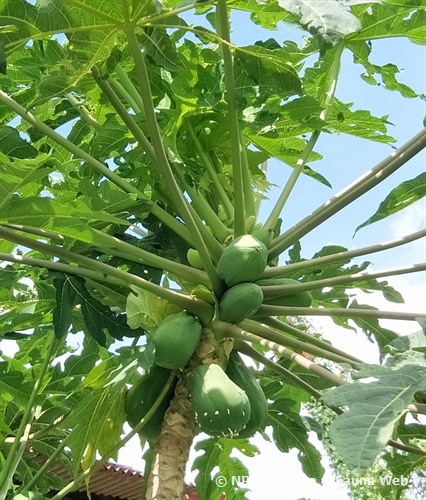
.jpg)
.jpg)
